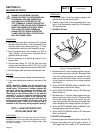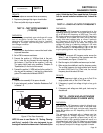
AC GENERATORS
SECTION 2.4
DIAGNOSTIC TESTS
5. Turn the Main Breaker to the "ON" or CLOSED position.
6. Set a VOM to measure resistance.
7. Connect one meter test lead to Wire 11 on the load side
of the main breaker. Connect the other meter test lead
to Wire 22 (power winding). Note the resistance read-
ing and compare to the specifications in the front of this
manual.
8. Connect one test lead to stator lead Wire 44 on the load
side of the main breaker. Connect the other test lead to
stator lead Wire 33 (power winding). Note the resistance
reading and compare to the specifications in the front of
this manual.
Note: Wire 11 and Wire 44 could be switched on
the main breaker. If an INFINITY reading is indi-
cated try putting the meter leads on the other
output terminal of the breaker. If INFINITY is still
read then an actual fault may exist.
9. Connect one test lead to Wire 22 at the voltage regula-
tor. Connect the other test lead to Wire 11 at the voltage
regulator (power winding sense leads). Note the resis-
tance reading and compare to the specifications in the
front of this manual.
TEST WINDINGS FOR A SHORT TO GROUND:
10. Make sure all leads are isolated from each other and
are not touching the frame.
11. Connect one test lead to a clean frame ground. Connect
the other test lead to stator lead Wire 11 on the load
side of the main circuit breaker.
a. The meter should read INFINITY.
b. Any reading other than INFINITY indicates a
“short-to-ground” condition.
12. Repeat Step 11 using stator lead Wire 33.
13. Repeat Step 11 using Wire 22 at the voltage regulator.
14. Repeat Step 11 using Wire 6 at the voltage regulator.
2
6
11P
44
33
22S (12-20 kW)
22P
11S (12-20 kW)
Figure 5. Stator Assembly Leads
TEST FOR A SHORT CIRCUIT BETWEEN WINDINGS:
15. Connect one test lead to stator lead Wire 11 on the load
side of the main circuit breaker. Connect the other test
lead to stator lead Wire 33.
a. The meter should read INFINITY.
b. Any reading other than INFINITY indicates a
short circuit between windings.
16. Repeat Step 15 using stator lead Wire 11; Wire 6.
17. Repeat Step 15 using stator lead Wire 33; Wire 6.
18. Repeat Step 15 using Wire 11 at the voltage regulator;
Wire 6 at the voltage regulator.
TEST CONTROL PANEL WIRES FOR CONTINUITY:
19. Connect one test lead to Wire 11 at the voltage regulator
and the other test lead at stator lead Wire 11
. Continuity
should be measured.
20. Connect one test lead to Wire 22 at the voltage regulator
and the other test lead at stator lead Wire 22
. Continuity
should be measured.
RESULTS:
1. Stator winding resistance values is a test of winding conti-
nuity and resistance. If a very high resistance or INFINITY
is indicated, the winding is open or partially open.
2. Testing for a “grounded” condition: Any resistance
reading indicates the winding is grounded.
3. Testing for a “shorted” condition: Any
resistance
reading
indicates the winding is shorted.
4. If the stator tests good and wire continuity tests good,
perform “Insulation Resistance Test” in Section 1.5.
5. If any test of wire continuity failed in the control panel,
repair or replace the wire, terminal or pin connectors for
that associated wire as needed.
NOTE: Read Section 1.5, “Testing, Cleaning and
Drying” carefully. If the winding tests good, per-
form an insulation resistance test. If the winding
fails the insulation resistance test, clean and dry
the stator as outlined in Section 1.5. Then, repeat
the insulation resistance test. If the winding fails
the second resistance test (after cleaning and
drying), replace the stator assembly.
TEST 8 – TEST BRUSHLESS STATOR
DISCUSSION:
The brushless stator has three internal windings,
two main power windings and a DPE winding. This
test will ensure that there are no shorts between the
power windings or shorts to ground.
A VOM meter can be used to test the stator windings
for the following faults:
PART 2
Page 45


















